Last updated: August 26, 2022
Article
How We Rescued the Ascension of Our Lord Church in Karluk, Alaska, from Falling off a Cliff
A successful move under challenging circumstances brings hope for preserving an important part of history for a remote Alaskan community.
By Shina duVall

Image © Dustin Reft
Alaska’s Kodiak Island is the second largest island in the United States. It is the homeland and traditional territory of the Alutiiq/Sugpiaq people.
On the west coast of the island lies the village of Karluk. It sits at the mouth of the Karluk River, one of the most important salmon fisheries in the world. Alutiiq speakers refer to Karluk Village as Kal’ut. This translates in English to “sun sets,” which speaks to its strikingly beautiful setting. The settlement is nestled on the shores of the Karluk Lagoon, flanked by dramatic hillsides rising up to cliffs that tower above Shelikof Strait. People have lived in the Karluk area for at least six thousand years, and possibly longer.
Since the early twentieth-century, ships have traveled the fierce and unpredictable waters of Shelikof Strait. From afar, seafarers can see the gleaming Ascension of Our Lord Church perched high on a hillside where the river meets the sea. The sight of the church brings them relief and comfort. The prominent and iconic church, a structure of remarkable architectural ingenuity, is a beacon of hope for ships on the strait. And it has been a sacred place of worship and gathering for Karluk residents for well over a century.
It was also almost lost forever.
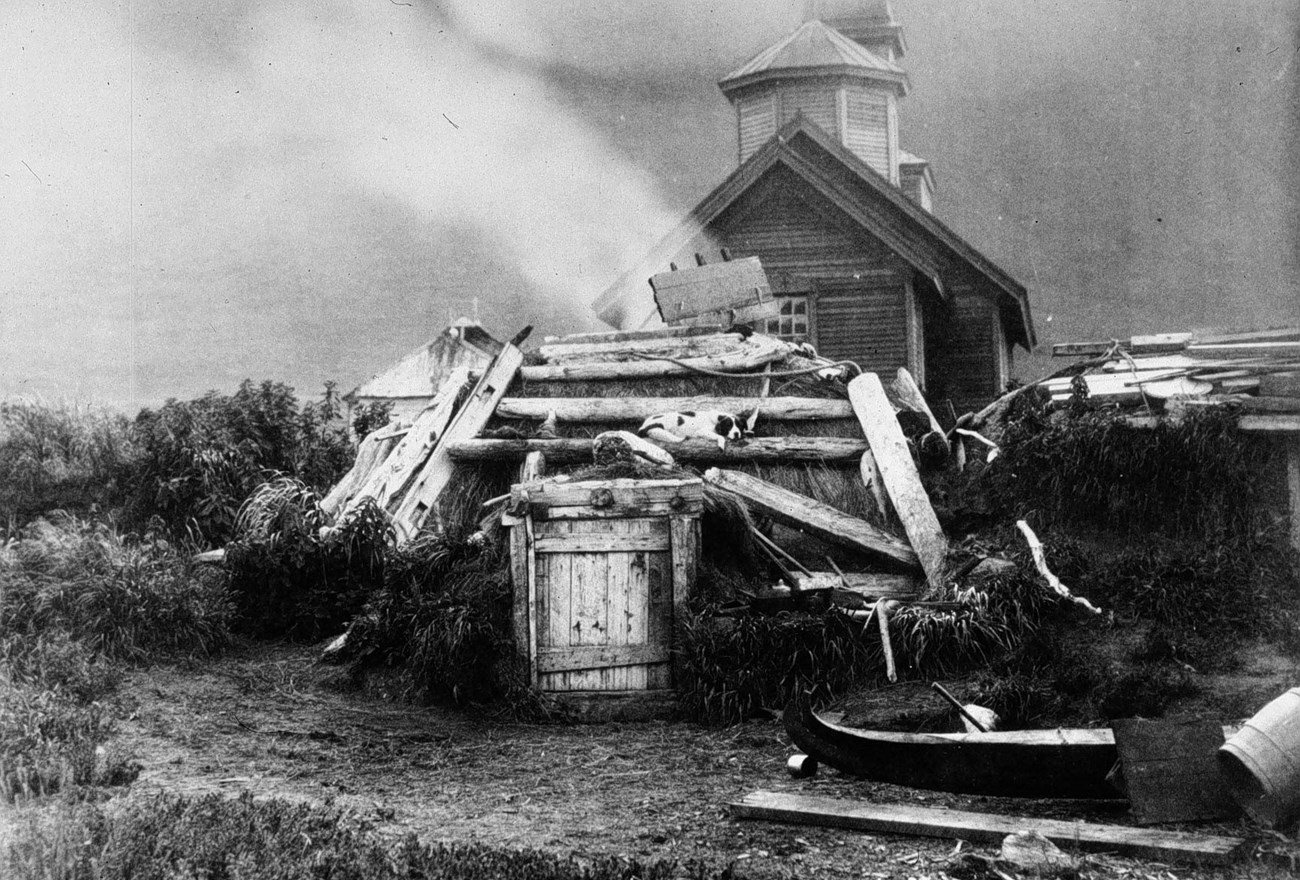
Image credit: National Archives / Tarleton H. Bean
A Complex History
The impact of colonization on Indigenous people across Alaska has been complex and painful. In most places, including Karluk, it resulted in loss of lives, well-being, land, resources, and traditional practices. For thousands of years, Indigenous people have stewarded the land, waters, and wildlife that make up this extraordinary place. At first contact with outsiders in the mid-1780s, the lives of people living in Karluk were forever transformed. Russian and American exploration, trading, resource exploitation, and cultural assimilation had a major and lasting impact.
“There is so much history in that church. So many memories. That’s how we remember our old people."
The Ascension of Our Lord Church represents the introduction of Russian Orthodoxy to the area, which partly replaced and blended with traditional Alutiiq/Sugpiaq cultural traditions. The structure and surrounding cemetery were quite literally built amidst an already densely occupied settlement. Today, the unique identity of the Karluk community is intricately tied to this place, along a thread that extends back from the present day for thousands of years. As Joyce Jones, a Karluk resident and key advisor on this effort, said, “There is so much history in that church. So many memories. That’s how we remember our old people. We don’t have a lot of old people here now. But you walk in that church, and it just brings back all the memories of the people that gathered there and the events that happened there. That church is what makes us who we are. That strength. It gives us strength and power.”
When we thought about moving the church to safer ground, we sought opportunities to reflect honestly on the regrettable acts of colonization and to work collaboratively in partnership with Indigenous communities. One early goal was to transform decisions at all levels to be more community-driven, thoughtful, compassionate, and equitable.
The interdisciplinary planning team relied heavily on the insight, knowledge, and memories of the residents, parishioners, Tribal leaders, and local government from the community of Karluk to save this church. They were key participants in the working group, provided leadership and advice, and graciously hosted visitors during site visits. The community also took the lead in preparing the church and the site for the move.
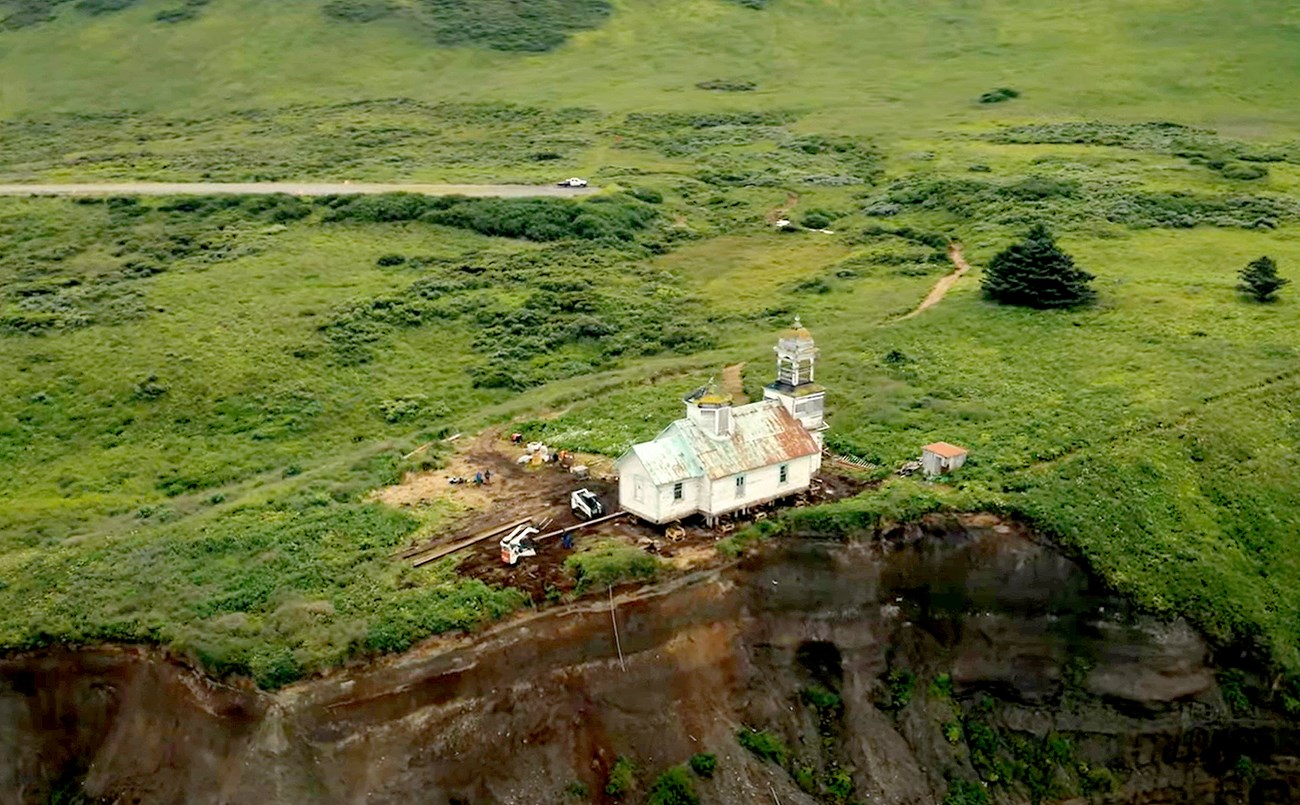
Image © Tom Pillifant
A Crumbling Location
The Ascension of Our Lord Church was built in 1888. It was listed on the National Register of Historic Places—the Nation’s official list of historic places worthy of preservation—in 1980. It is one of the oldest standing, still-used Russian Orthodox churches in Alaska. As a place of worship, blended traditions, community gathering, and cultural expression, this place is sacred to many individuals and families in Karluk. It holds powerful memories and experiences for members of the community, particularly for the Tribal elders, who pass their intergenerational stories down to younger generations.
Besides the church building and associated structures, there are archeological remains associated with the site’s more than 6,000-year occupation. The surrounding community cemetery contains upwards of 600 graves. There are multiple headstones and crosses, supportive wooden structures, fencing, and raised mounds.
The church was built on a gradually sloping hillside above the Karluk River and Karluk Lagoon, overlooking Shelikof Strait. According to a 2007 U.S. Army Corps of Engineers report, the hillside was protected by a spit until 1978, when a storm breached the spit, causing new outflow from Karluk lagoon. The bluff began to erode during high tides at an annual rate of about three to five feet. By the summer of 2021, the dramatically undercut bluff was within 10 feet of the north side of the church.
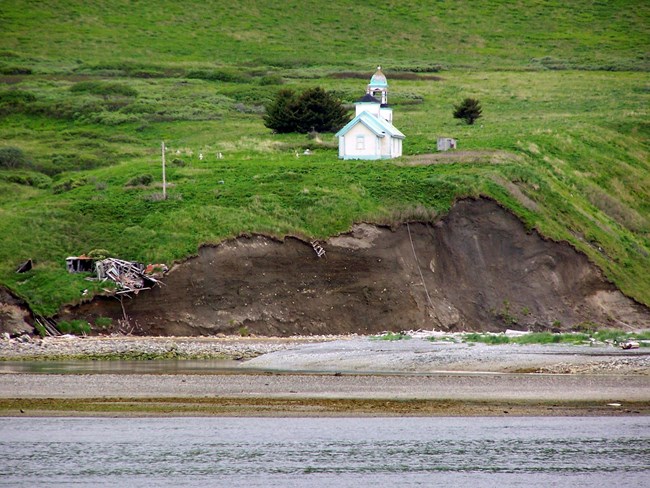
Image credit: Alutiiq Museum / Jill H. H. Lipka, AM937
Karluk One
In the 1980s and 1990s, archeologists excavated the village site known as Karluk One, immediately below the bluff on which the Ascension of Our Lord Church is presently located. This was because dramatic erosion at the mouth of the Karluk River into Shelikof Strait threatened the site. Karluk One was settled around 600 years ago. It has since been completely destroyed.
The area of Karluk One is also known by residents as New Karluk, which distinguishes it from an area known as Old Karluk located on the opposite shore and across the Karluk Lagoon. The modern Village of Karluk, which was established in 1980 and is occupied today, is now safely located further up the Karluk River, protected from the areas along the coast that are most vulnerable to erosion.
An Urgent Need and a Plan to Meet It
Residents of Karluk had been monitoring the crumbling site for decades. Finally, in 2020, a diverse working group came together to plan for moving the building inland. Guided by residents and parishioners in Karluk and the Karluk Tribal Council, the working group included representatives from the Russian Orthodox Diocese of Sitka and Alaska and the Russian Orthodox Sacred Sites in Alaska, a nonprofit organization. The Alaska Association for Historic Preservation, the Alaska Office of History and Archaeology, the National Park Service, and the Bureau of Indian Affairs also participated. The working group frequently consulted descendants of people buried in the cemetery.
Staff from the National Park Service Alaska Regional Office provided technical support through the region’s Heritage Assistance Program. This program extends the benefits of cultural resource preservation throughout the state of Alaska. The costs associated with the planned building move were considerable. Russian Orthodox Sacred Sites in Alaska and Alaska Association for Historic Preservation worked hard to fundraise. Their efforts were rewarded in 2021 when an organization (that wishes to remain anonymous) donated the nearly $500,000 needed for the move. This was an incredible and welcome development.
Despite the project’s complexity, the working group recognized the urgency of the situation and persevered. With the funds committed, a plan for the move materialized over summer 2021. We completed a number of critical tasks in advance of the move. Members of the community worked tirelessly to carefully pack, remove, and store all iconography and sacred objects from inside the church. Several working group members made preconstruction site visits to assess the integrity of the structure and evaluate the proposed new footprint.
We consulted with the building movers, mapped out the move route, and held weekly meetings to strategize. We determined that it would be necessary to first move the building to a temporary location still within the existing parcel owned by the diocese. The working group is exploring options for a new permanent home for the church. But the critical nature of this situation required us to move the building before we could find a permanent location. Once the diocese and community acquire a permanent site, it will be easier to transport the building there.
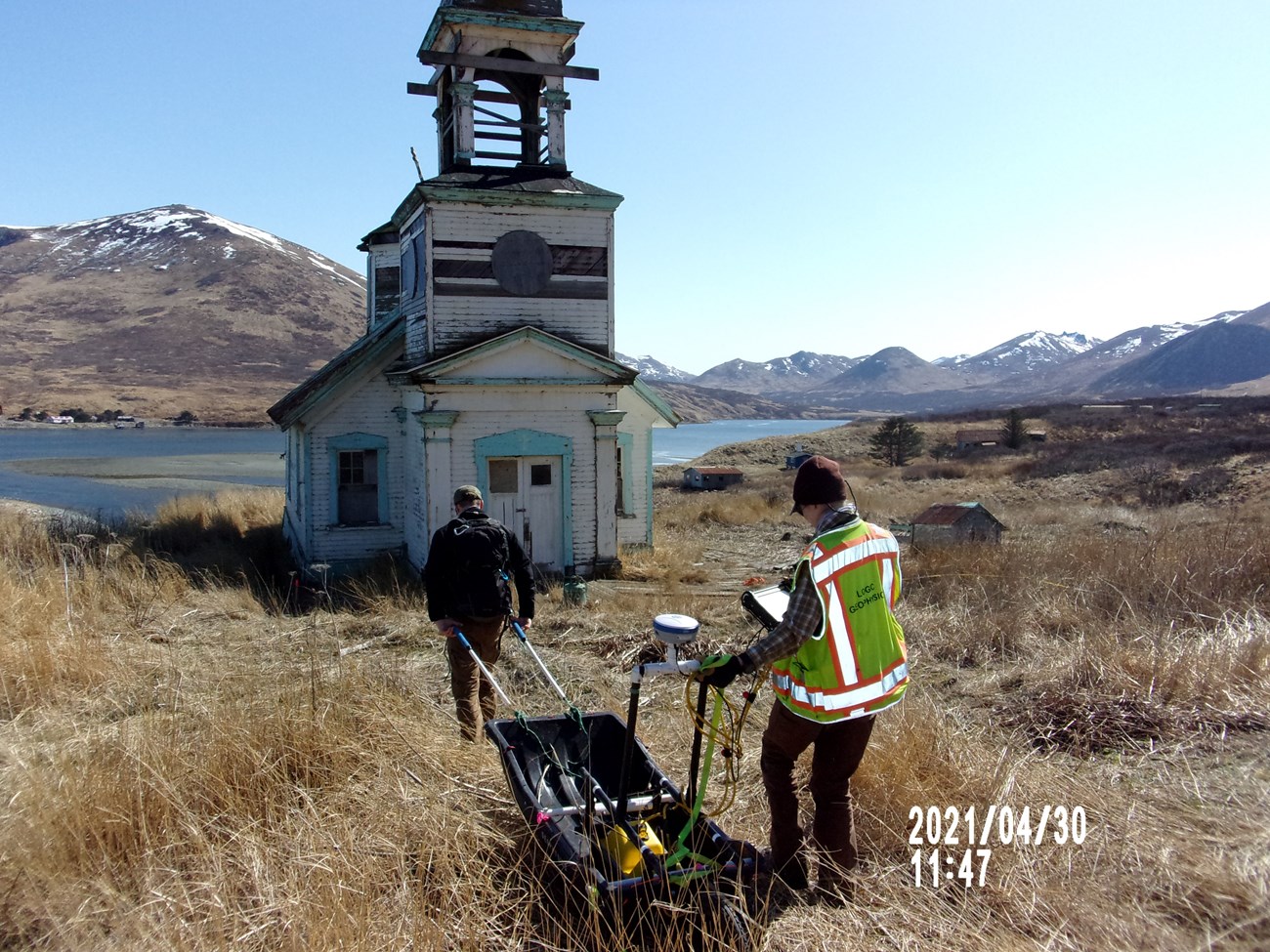
Image © Logic Geophysics / Esther Babcock
Radar to the Rescue
One of our most important tasks was to survey a portion of the site with ground penetrating radar (GPR). GPR is a valuable tool for non-destructively investigating and analyzing sensitive sites like cemeteries. It allowed us to gather data for an initial site assessment and determine which areas within the site would be most vulnerable to damage during the move. It also helped us make a long-term plan for the cemetery.
“Relocating graves is a complicated, culturally sensitive endeavor."
“Relocating graves is a complicated, culturally sensitive endeavor for these Alaskan communities,” said Esther Babcock, the geophysicist who completed the GPR survey. “However,” she added, “before graves can be relocated, they must be located. Geophysical methods provide a tool for locating graves in locations impacted by climate change, whether to move the graves or for other reasons.”
GPR uses electromagnetic energy traveling as waves to gain information about subsurface conditions or object locations. Where the energy encounters a change in electrical properties, the change is reflected to a receiver. Several factors are relevant when considering the suitability of GPR as a technique for data collection at a site like Karluk. Soil type and density, water content, and minerology are all important. Collaborating with descendant communities is critical for understanding past and contemporary burial practices. This knowledge aids us in determining the likely presence of formal coffins, simple boxes, other containers, or their absence. The type of burial influences how successful GPR investigations will be.
We conducted the GPR survey at the site in Karluk in two phases. The first phase was completed in advance of the initial building move and covered a rectangular area of approximately 15,000 square feet (1,400 m2) west-southwest of the building. The analysis of this initial survey found a total of 174 likely graves. The graves were from two to six feet (0.6 to 2 m) below the surface, and several were co-located or overlapping at differing depths.
The second phase was completed after we moved the building. This phase covered an L-shaped area of approximately 64,500 square feet (4,600 m2). This brought the total surveyed area to approximately 1.5 acres (6,000 m2). The analysis of the second survey found 434 additional likely burial locations, bringing the total suspected burial locations to 608. The graves were predominantly oriented northeast to southwest.
The GPR survey showed the team where the burials were located and how to best avoid adversely affecting them during the move. It confirmed for the community specific details about the burials. For example, it helped us know which burials are vulnerable to continued erosion and how much effort it would take to relocate them.
“Our family and ancestors are buried in the cemetery. Saving all of it means saving who we are as a people of Karluk. Not just us that live here now, but those who no longer do.”
This information meant a great deal to the community. “The church, cemetery, and property is very important to Karluk, as this is all a part of our heritage,” explained Sarah Reft, a working group participant from Karluk. “Our family and ancestors are buried in the cemetery. Saving all of it means saving who we are as a people of Karluk. Not just us that live here now, but those who no longer do.”
Babcock completed the work under contract with the Russian Orthodox Sacred Sites in Alaska. She expressed confidence in the conditions during data collection and the quality of the data collected. But she did identify several factors that could cause uncertainty, such as the age of the burials, the materials used for caskets, moisture levels, and other soil properties.
Russian Orthodox Sacred Sites in Alaska has been an instrumental and leading partner in this project. Dorothy Gray is chair of the organization’s board and a tireless advocate for the church. “During the early 1900s, the village of Karluk housed one of the most productive salmon canneries on the entire west coast of the United States,” she said. “The church cemetery reflects the various people and cultures who were a significant part of that history. If any graves are in danger of being exposed due to climate change and erosion, it will be our sacred duty to move them to the new permanent location of the church.”
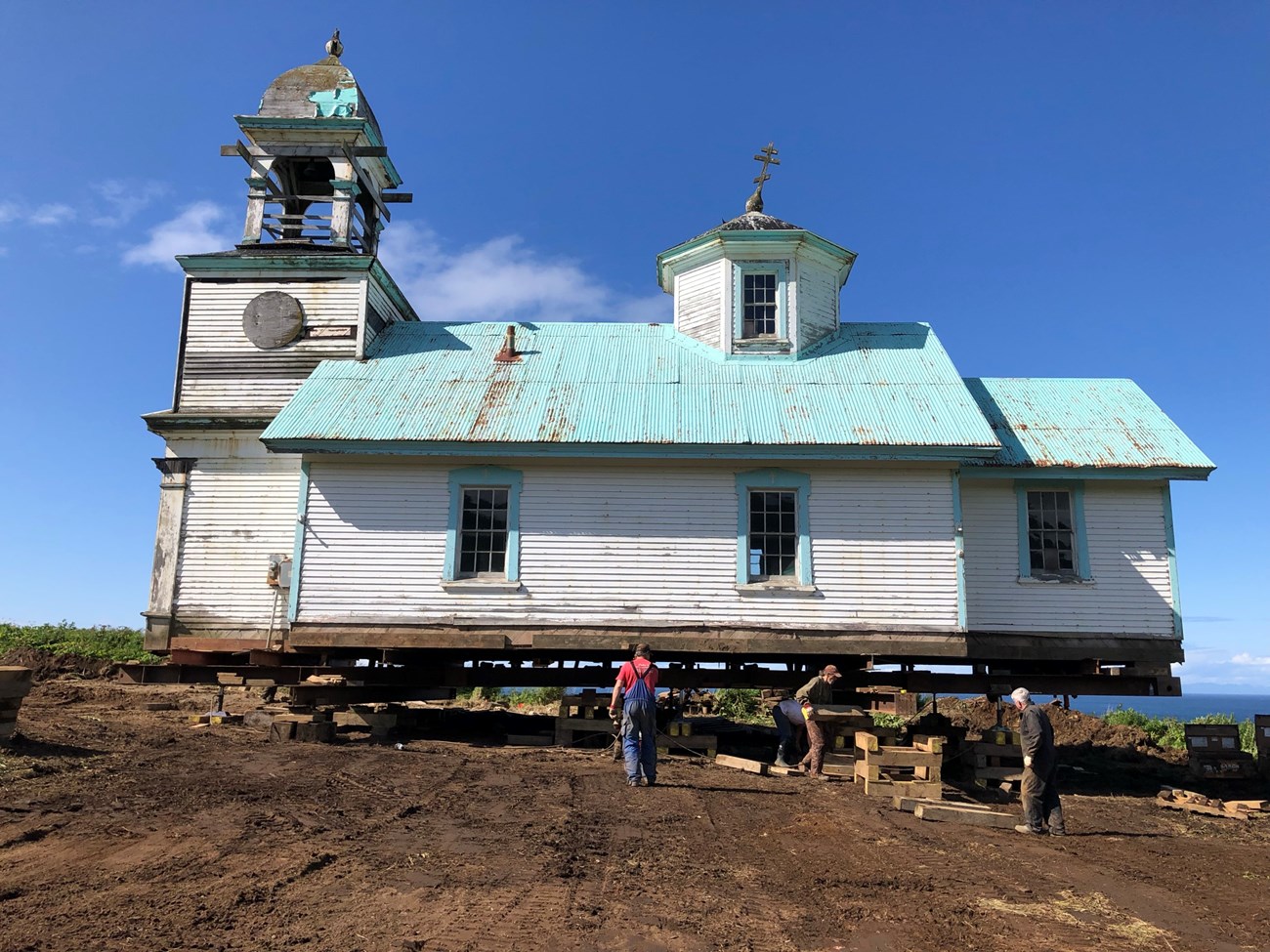
Image credit: NPS / Shina duVall
The Move
Karluk is only accessible by air or water. Getting personnel, materials, supplies, and heavy equipment there is no small task. Professional building movers took the equipment and supplies by road from their warehouse in Wasilla to Homer, Alaska. Once there, they loaded everything onto a barge headed for Kodiak. In Kodiak, everything was unloaded and reloaded onto another barge destined for Karluk. This took several days.
The tidal range in Karluk is remarkable. Shelikof Strait is known for its extreme tidal flow due to its proximity to Cook Inlet, which can have maximum tidal variances of up to 40 feet. Landing a barge in Karluk requires agreeable weather and nine-foot (or greater) tides. If the tides are not high enough, a barge of that size could be grounded offshore. We had to carefully coordinate the timing of the barge’s arrival. Some members of the moving team traveled with the equipment on the barge, and others flew in on small aircraft from Kodiak.
The COVID-19 pandemic made the move even more complex. But the project team was extremely conscientious about ensuring that no outsiders introduced the virus to the Karluk community. All nonresidents followed strict testing, masking, and social distancing protocols during travel and while on site.
Landing a barge in Karluk requires agreeable weather and nine-foot (or greater) tides. If the tides are not high enough, a barge of that size could be grounded offshore.
Once on location, the movers immediately got to work preparing the site. They removed the boardwalk from the perimeter of the building and the wooden skirting from around the foundation of the church. They carefully excavated the deeper soils beneath the building so that there was sufficient room to place the steel beams and cribbing needed for the move.
Once they had placed the cribbing, beams, and jacks, the contractors began to raise the building as high as six feet above the ground. They placed rollers on the beams and used two bobcats to pull the building first to the south, then east, then south again before it was set down securely at the southeastern corner of the parcel, about 80 feet from the bluff’s edge.
As a professional archeologist, I worked alongside the movers and members of the community to monitor the entire process. I documented some relatively recent artifacts in disturbed contexts, but I did not observe any disturbance to significant archeological deposits or features. Most critically, no marked or unmarked graves were damaged or disturbed. Five contractors, several community working group members, and a professional videographer who documented the work were on site. Several other residents, including Tribal Elders, visited the site, observed our progress, and advised the team.
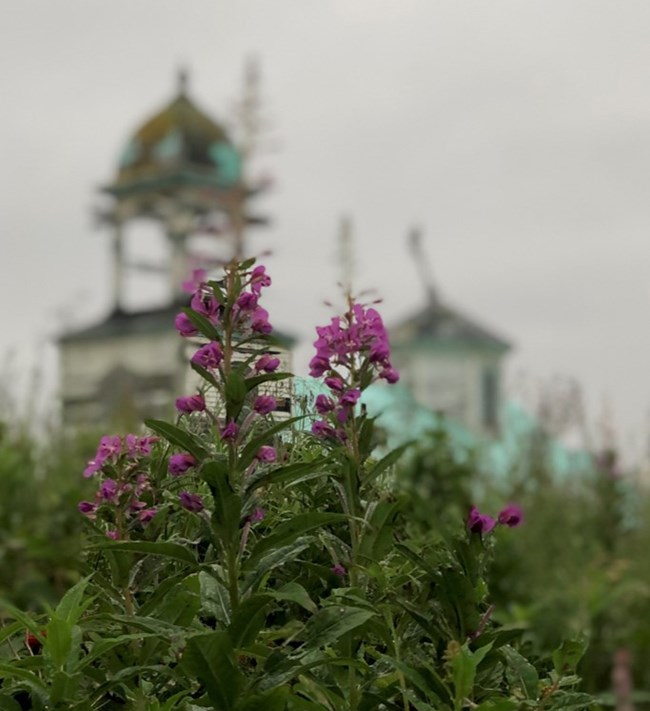
Image credit: NPS / Shina duVall
More Work Ahead
The success of this temporary move has encouraged and motivated us, but it is just the first step to save this iconic building. The surrounding site and cemetery are also incredibly important and sacred to the community of Karluk and to people with connections to Karluk and Kodiak Island. We have much more work to do.
Our first priority is to identify and secure a permanent site for the church and reinforce the route to its permanent home. We also need to assess the vulnerability of the features and gravesites that remain and determine the best way to protect them.
We will also assess the condition and preservation needs of the iconography and liturgical items that were removed from inside the church. Finally, we need to fully restore the church once it arrives at its permanent home. We will do all of this in continued collaboration with the community and descendants.
But for now, the Ascension of Our Lord Church is protected from falling off the bluff, and that feels like an accomplishment worth celebrating.
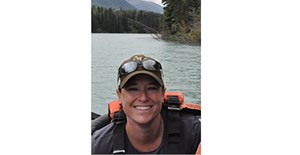
About the author
Shina duVall is the regional archeologist for the National Park Service Interior Region 11–Alaska. She provides leadership, assistance, oversight, and coordination on archeological and cultural resource issues affecting national park units and a wide variety of partners in Alaska. Shina has over 20 years of experience supporting, managing, and reviewing archeological, cultural resource, and historic preservation projects through her work in private, government, higher education, and nonprofit sectors. Image courtesy of Christy O'Connell.
